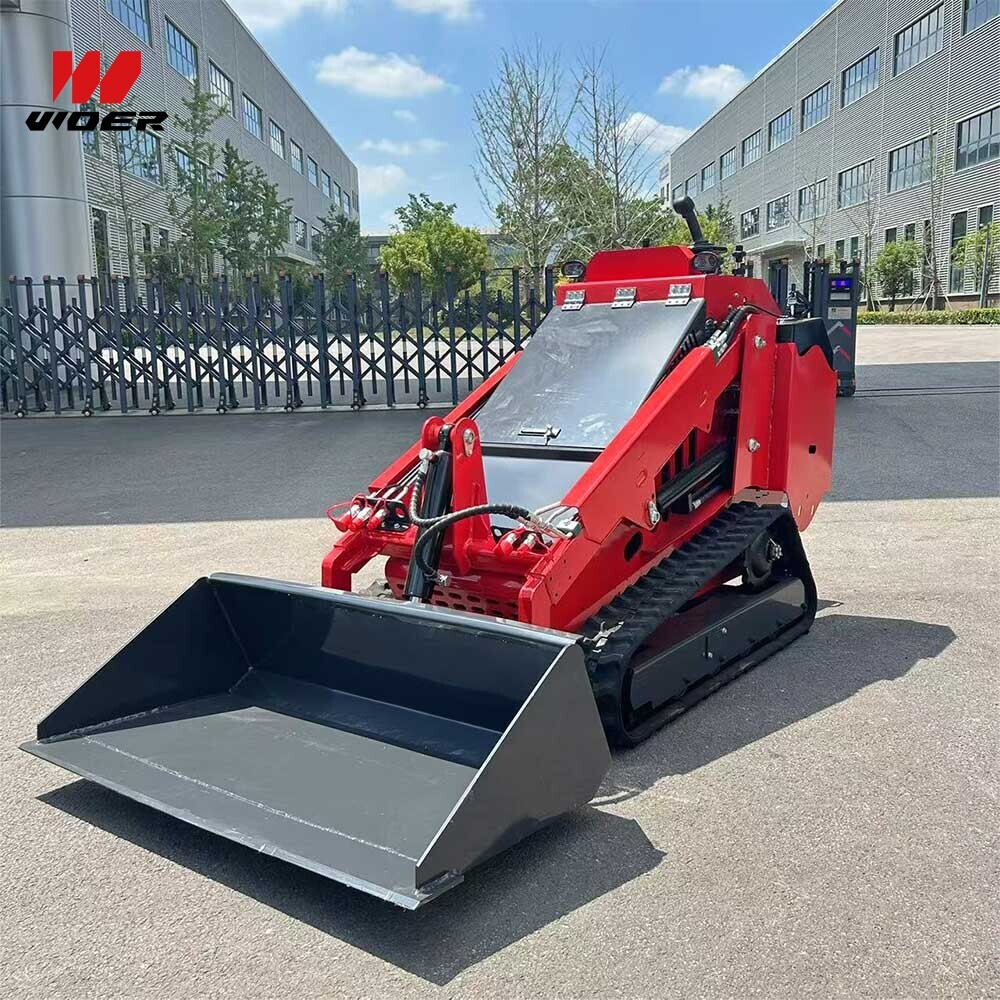Navigation
Contact us
Phone
Message

This article compares skid steer loader track systems and tire setups to help operators and buyers decide which configuration best fits their projects, terrain, and budget.
Why the choice between tracks and tires matters
For professionals evaluating a skid steer loader, the undercarriage choice is among the most consequential: it affects traction, stability, ground impact, operating costs, and machine versatility. Whether you are assessing a full-size skid steer loader or a smaller mini skid steer loader, understanding the trade-offs between a skid steer loader with track and one with tires guides purchasing, fleet deployment, and jobsite planning.
Key operational considerations
Operators focus on traction, flotation, and maneuverability. Contractors and procurement teams add cost of ownership, downtime risk, and suitability for specific applications. A track loader skid steer typically delivers superior flotation, reduced ground pressure, and better traction on soft or uneven surfaces. Conversely, a skid loader with tires often offers higher travel speed, lower upfront cost, and easier field repairs.
Performance comparison: traction, flotation and stability
Tracks disperse machine weight across a larger footprint, lowering ground-bearing pressure and minimizing rutting. This makes a track skid steer loader ideal for landscaping, forestry, wet clay, and marshy conditions. Tires concentrate weight at contact patches, so a mini loader skid steer with tires may struggle in soft ground but excels on paved or compacted surfaces where rolling resistance and efficiency matter.
On-slope and uneven terrain
A track skid steer loader typically offers improved lateral stability on slopes and better resistance to washouts. Operators handling demolition or grading on variable terrain often prefer track skid steer loaders for predictable traction and reduced slip risk.
Product integration example
For jobs that demand all-terrain mobility without committing to a full-size machine, consider compact, hydromechanically robust solutions such as Garden Rubber Track All Terrain Hydraulic Mini Tracked Dumper which exhibits the benefits of rubber track design—low ground pressure, vibration damping, and reliable steering in confined areas.
Cost analysis: acquisition, maintenance and lifecycle
Upfront cost: Track conversions and purpose-built track models generally increase acquisition cost versus comparable tire models. However, life-cycle costing often narrows that gap when tracks prevent jobsite rework and reduce soil remediation expenses.
Maintenance: Tires are easier to replace in the field; spare tires and a portable jack can fix many issues quickly. Tracks require specialized replacement procedures and may be more expensive per-unit, but modern rubber track systems have improved longevity and reduced vibration, reducing wear on the carrier components.
Depreciation and resale: Market demand and regional preferences affect resale. In areas dominated by landscaping and soft ground work, tracked skid loaders hold their value better; in urban construction markets, tire-equipped skid loaders may find broader buyers.
Application scenarios and recommendation matrix
Below is a concise comparison to help match machine to mission.
Health, safety and environmental factors
Tracks reduce soil compaction and limit disturbance to sensitive sites, which is important for urban landscaping, restoration work, and environments with erosion concerns. OSHA-style jobsite planning benefits from predictable machine behavior; operators should follow manufacturer guidance and local standards (for example, referencing ISO or EN standards that govern lifting and stability for compact machinery) to ensure safe operation.
Technical considerations and standards
When specifying a track or tire option, verify compatibility with loader hydraulics, drive sprockets, and carrier components. Rubber track compounds often conform to industry material standards such as ASTM rubber testing methods (e.g., ASTM D412 for tensile properties) and may be manufactured to ISO 9001 quality systems. Buyers should request service intervals, recommended track tension, and OEM replacement part references to reduce lifecycle risk.
Common operator concerns and misconceptions
Myth: Tracks always require expensive service. Reality: Modern rubber tracks are robust; correct tensioning and routine inspection extend life significantly. Myth: Tires are universally cheaper. Reality: On soft ground, tires can increase job time and require frequent replacement, raising total cost.
Buying advice and procurement checklist
For decision-makers procuring a skid steer loader china or from other markets, consider these steps: assess dominant terrain, analyze jobsite transport constraints, calculate life-cycle costs (including potential site remediation), confirm dealer service capability for tracked systems, and request test sessions to evaluate machine behavior in representative conditions.
- Define primary applications (grading, digging, lifting, mulching).
- Project annual operating hours and site soil types.
- Request OEM or dealer references for uptime and maintenance.
- Confirm availability of spare parts and field service.
- Evaluate total cost of ownership over expected machine life.
Case snapshot: a mixed-fleet strategy
Many operators adopt a hybrid fleet: tracked mini skid steer track loader units for sensitive or soft sites and tire skid loaders for urban paving or high-speed transport. This approach balances versatility, cost efficiency, and downtime risk. Fleet managers often source tracked units for winter and landscaping contracts, deploying tire units for stockpiling and loading on hard surfaces.
Why choose our support and how to contact us
We combine product knowledge, regional service networks, and practical experience with skid steer loader, mini skid loader and mini loader skid steer applications. Our team helps spec machines to standards, arranges demo trials, and supports parts and maintenance planning to maximize uptime. For inquiries, equipment quotes, or to schedule an on-site demonstration, contact our sales team through the website or request a consultation.
Final recommendation
There is no single winner. Choose a track skid steer loader when flotation, minimal ground disturbance and traction on soft or irregular terrain are priorities. Choose a tire skid loader where speed, lower acquisition cost, and simple field service are more valuable. For many operators, a mixed approach yields the best operational flexibility and cost control.

This stunning beach house property is a true oasis, nestled in a serene coastal community with direct access to the beach.
Contact
West Street, Melbourne Victoria 3000 Australia